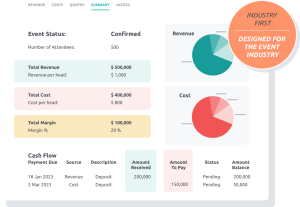If money appeared out of thin air, then there wouldn’t be a need for sponsorship. Of course, building sponsorships is a reality and part of the business if you routinely host events.
Getting a sponsor isn’t easy especially if you’re a startup; ultimately, there’s going to be more misses than hits when sending out your proposal. Nevertheless, there are a few tricks to help you acquire corporate sponsorship for events and keep them for the long-term.
1. Know Your Demographic
It doesn’t make sense to be requesting sponsorship from a food distribution company if you’re in the information technology field. You should be reaching out to sponsors within your own niche. This means you’ll also share the same demographic. This makes it all the more important to understand your audience.
One way to look at the situation is to treat sponsors as if they were your customers. This way, if you know your demographic, then you also know your sponsors. You’ll know the best approach for getting their attention and putting together a proposal that elicits a call-back.
If your demographic typically responds to trial offers, for example, then perhaps you can offer a trial deal of your own, perhaps one where they only fund a small portion of the event just to test the waters, so to speak.
2. Prepare a Winning Sponsorship Proposal
Your proposal is not unlike a job resume. Remember, sponsors review a dozen proposals on a near daily basis. They all begin to look alike after a while, so you need yours to stand out. How do you do this? The trick is to keep it formal and brief, all while showing that you did your homework.
The proposal should contain an introduction explaining your company, the event, why you’re hosting the event, and why you’re requesting sponsorship.
Beyond the intro, you need to get more detailed. You should, for example, include a report, preferably with graphs or charts. This can be an outline of a past event showing attendee numbers, ROI, etc. Follow it up with projected numbers and metrics for the planned event for which you’re seeking funding.
3. Prepare a Sponsorship Package
Here’s the deal: you need your sponsors way more than they need you. Therefore, you have to be willing to do more giving than receiving, at least in the beginning. The package needs to include what you’re offering in return. Preferably, there should be multiple tier levels you’re proposing.
Here’s an example of a multi-tier proposal:
- Tier 1: $3,000 sponsor fund – will include sponsor logo on all swag items
- Tier 2: $5,000 sponsor fund – tier 1 + tradeshow booth setup for sponsor
- Tier 3: $8,000 sponsor fund – Tier 1 & 2 + free event ticket for sponsor’s loyal membership members
You also need to be flexible to suggestions from the sponsors. They may ask for a bit more, and you need to be willing to accommodate those additional requests if it’s within reason.
4. Negotiate and Follow Up
This builds off on the last step. The sponsor ultimately is looking for the best offer for them. In other words, they may ask you to tweak your tier options. They may, for instance, express interest in tier 2 but only if the fund can be reduced to $4,000.
You can provide a counter offer with a middle ground option, perhaps $4,500. The tiers are really only suggestions, so don’t treat them as a take-it-or-leave-it deal. Be willing to compromise and agree to a package that both parties can agree is beneficial for everyone.
5. Customize Your Proposal
Sponsors can spot a generic proposal a mile away. By customizing a proposal, this doesn’t mean creating one proposal and just swapping out the sponsor company name. The sponsor should be made to feel like you came specifically to them for a reason. You’re going to have to research the company to look for some common points of interest.
Perhaps your company and the sponsor share the same geographical location or donate to the same charity. Find some kind of commonality and point that out to make it apparent that the submitted proposal isn’t the same one that you sent to a dozen other companies.
6. Showcase Your Brand Advocates
Like employers, sponsors prefer people with past experience. What do you do then, if you’re a young startup with minimal social media following and zero event-hosting experience? Don’t count yourself out just yet.
Some work may be required before sending out your proposal. Yes, you need some time to build your consumer base. You also need to surround yourself with brand influencers. Your proposal should include examples of some of your biggest brand advocates and some of the user generated content they created on your behalf. Even if you don’t have the biggest social media following, sponsors will be impressed by the eager beaver-ness of your most loyal followers.
Ultimately, it’s all about quality, not quantity, and your advocates could also indirectly end up being advocates for your sponsors. You can also reach out to these advocates and ask them to incorporate the sponsor’s brand into their content. In return, they’ll get a free event ticket or some other incentive. The bigger the advocate’s social media following the better.
7. Build a Relationship
The relationship shouldn’t be a one-time endeavor, not if you plan to have future events. It’s a lot easier, after all, to get funding from a former sponsor than to contact an entirely new one. This is why you should keep the relationship going long after the event. Occasionally reach out to them to keep your brand fresh in their minds. How do you do this?
Consider these methods:
- Volunteer your staff for your sponsor’s own events
- Make a donation to a charity your sponsor is active in
- Extend limited-time offers to your sponsor’s followers or propose a cross-promotional sale
- Be a brand advocate and provide UGC for your sponsor when they’re having their own event or product launch
We hope this guide to sponsorship provides some useful insights. Not every submitted proposal will be answered; in fact, most sponsors won’t respond at all. Just be persistent; somewhere out there is a sponsor that has enough faith in your event. You just have to be the one to initiate contact.
Dan McCarthy is an Event Manager at VenueSeeker, a comprehensive online venue guide based in the UK. Dan has 5 years of event project management under his belt. He has worked on many successful events and currently, he shares his knowledge by writing on the company blog. Follow him on Twitter @DanCarthy2.
This post originally appeared on the old Plannerwire.
Sign up now, all the cool kids do it!





